The ASUS Zenbook UX305 Review
by Brett Howse on March 25, 2015 8:00 AM ESTSystem Performance
ASUS has employed the Intel Core M processor in the design of the UX305, and unlike the first device we tested with Core M, ASUS has created the UX305 as a fanless design. This is likely easier to achieve when you consider that the UX305 is completely constructed out of aluminum. Aluminum is a great conductor of heat, and allows a big part of the laptop to be a cooling surface. The heat is also kept at the top of the keyboard deck, where it is less likely to be noticed when using the laptop. During most general use of the UX305, it does not get warm anyway, and only when used for extended periods of high use did I notice it get hot.
The UX305 will be offered with either the Core M-5Y10 or 5Y71 processors, although for North America the 5Y10 is the only available processor right now. It is a dual-core, quad-thread CPU with an 800 MHz base frequency, and 2 GHz boost frequency. This is a big step down from the 5Y71 which has a 1.2 GHz base and 2.9 GHz boost capability, so it will be interesting to see how the UX305 performs. I have highlighted the Lenovo Yoga 3 Pro since it is the only other Core M device we have tested, and it has the Core M-5Y71 processor onboard.
To compare the performance, I have selected a sampling of devices that we have tested which are roughly the same class of device. To compare the UX305 to any other device we have tested, please use our Notebook Bench.
PCMark
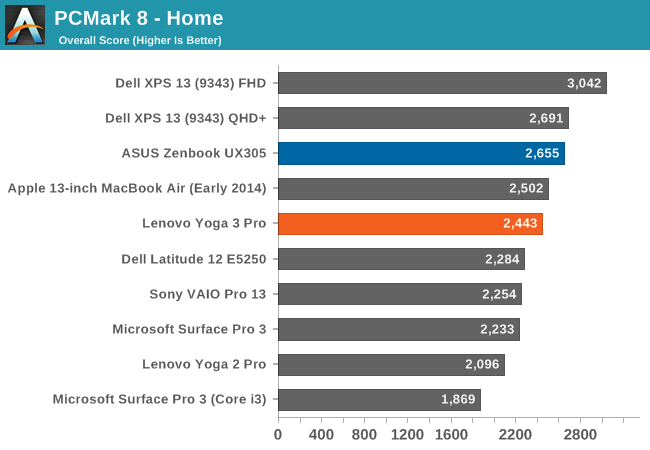
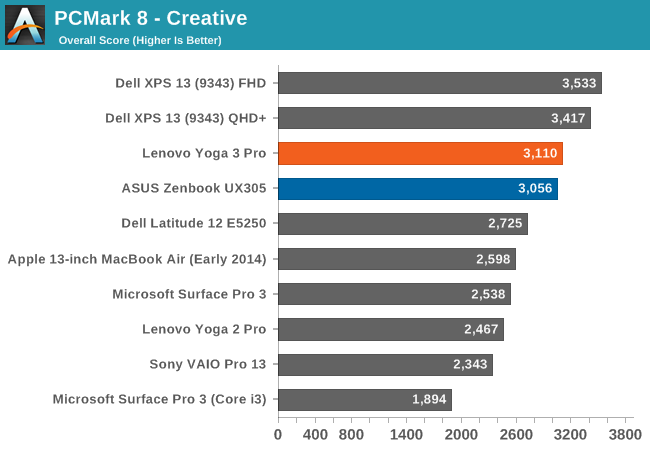
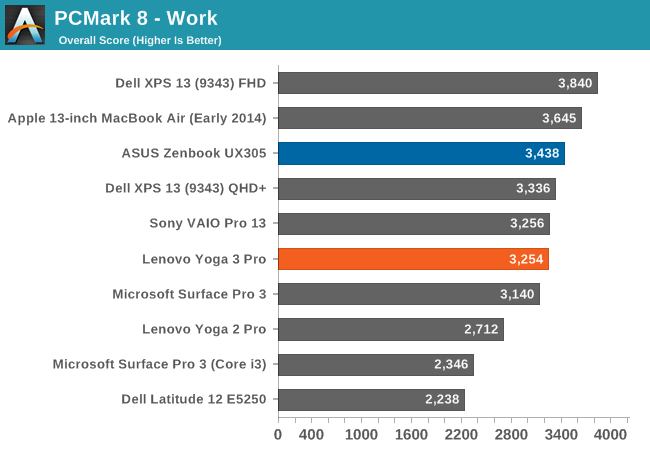
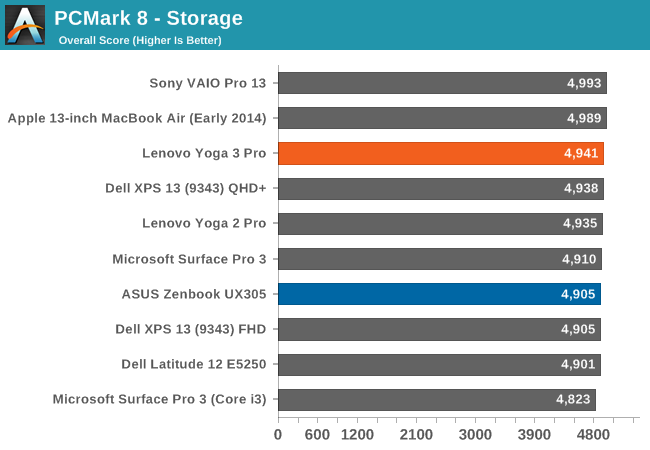
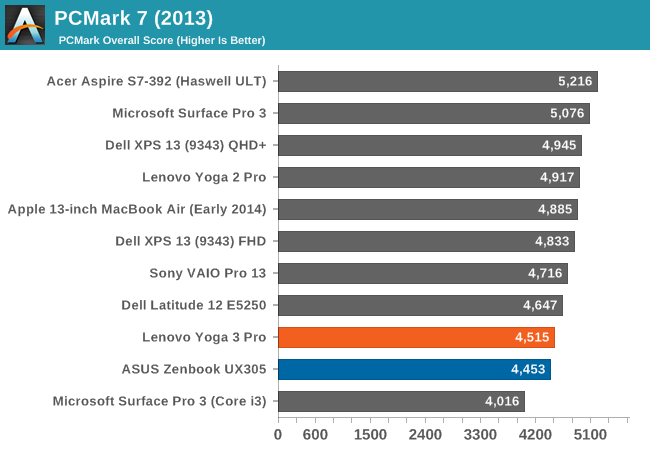
PCMark 8 performs four sets of tests, with different use case scenarios to get a feel for how the device will perform on several different sets of tasks. The UX305 performs quite well here, despite the Core M processor. You can see that it even outperforms the Yoga 3 Pro on several of the tests, and it has a faster version of the Core M CPU. We will dig into that more in a bit.
Cinebench and x264
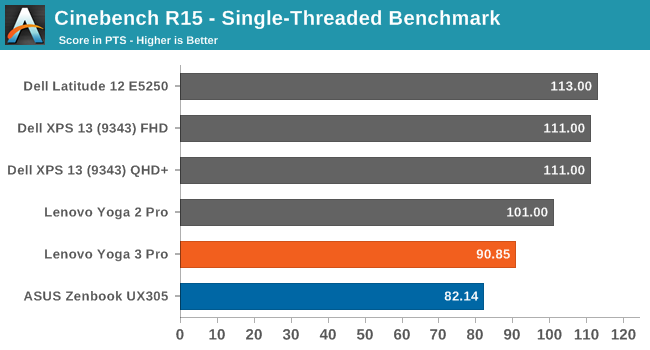
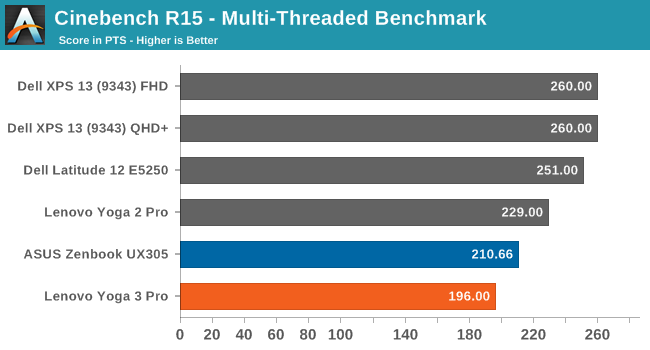

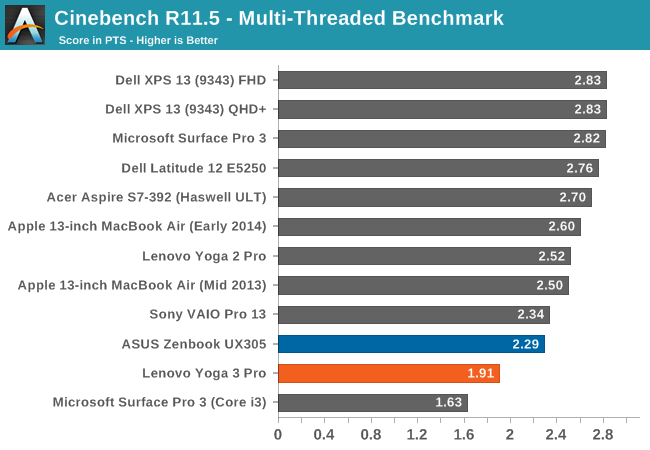
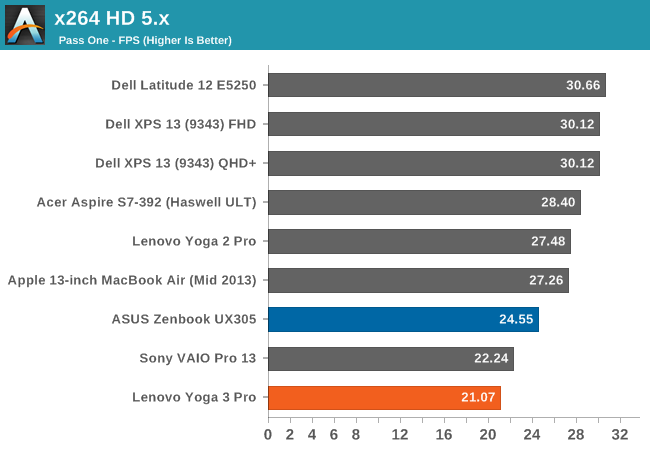
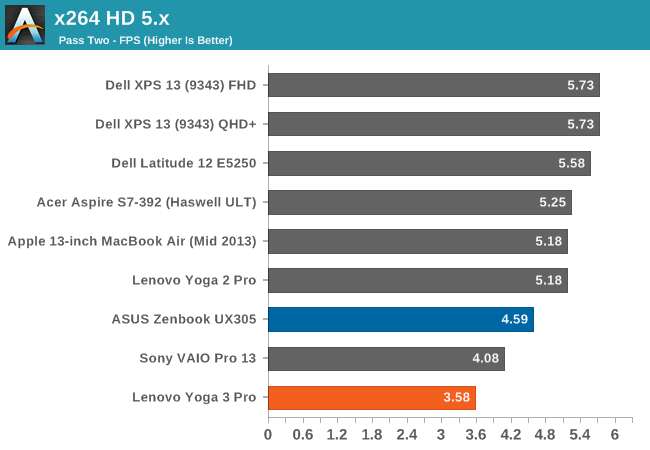
On the single-threaded runs of Cinebench, The UX305 is near the bottom of the pack. That is unsurprising, since it has a boost clock of just 2 GHz, and furthermore on a single-threaded runs most CPUs can usually perform very close to their boost clock for the duration. Consequently the extra 900 MHz on the Yoga 3 Pro's 5Y71 pulls a big lead here. It is interesting to note that the only Haswell-Y based processor that was in Bench was the Core i3 version of the Surface Pro 3. Broadwell-Y (Core M) handily outperforms it in both single and multi-threaded workloads. This has a lot to do with the Core i3 having no boost clocks at all.
Moving on to the Multi-threaded workloads, we can see that the UX305 is still near the bottom of the chart, but it has passed the Yoga 3 Pro with 5Y71. The same thing occurs on the x264 benchmark, which lasts several hours. We need to see a couple of more benchmarks to get an idea of what is going on.
TouchXPRT 2014
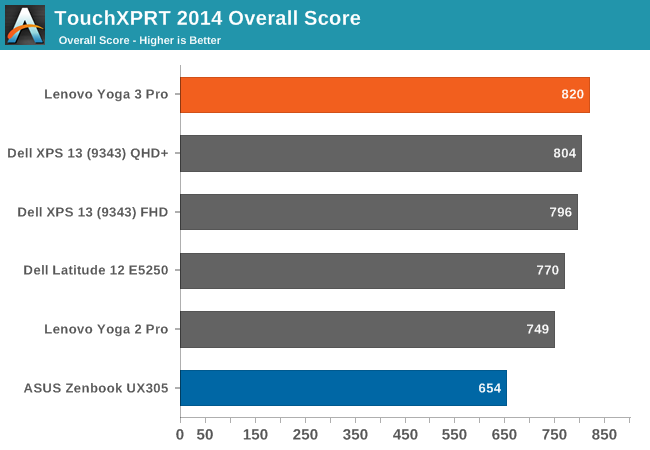

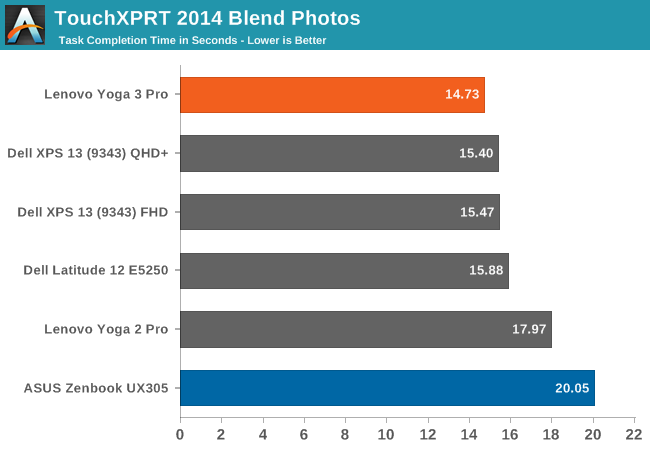
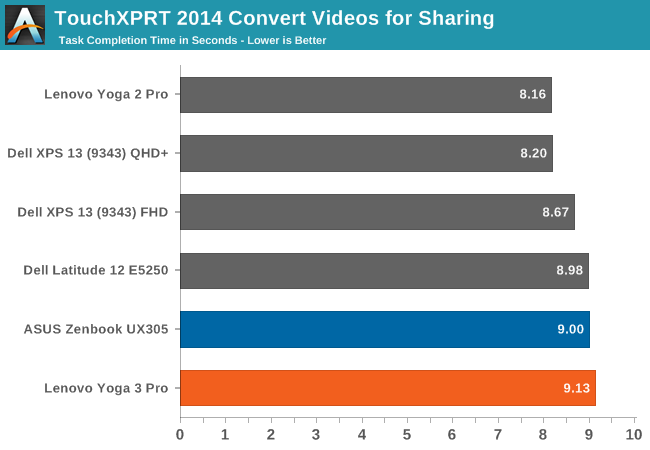
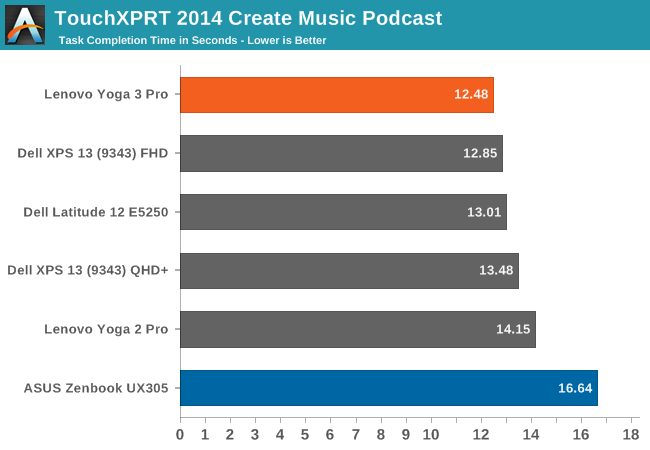
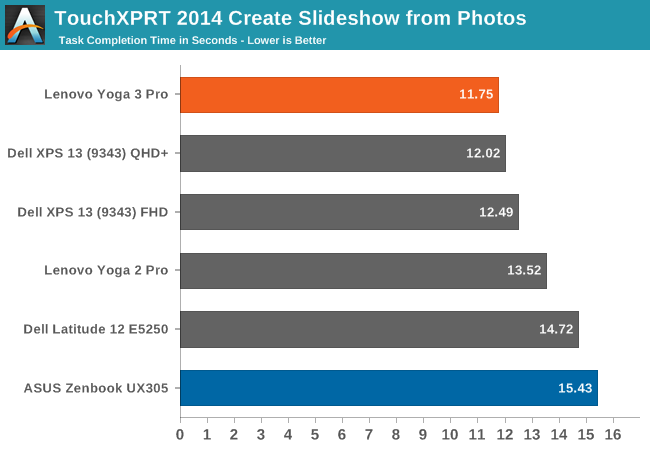
TouchXPRT is a Windows Store benchmark which performs several common tasks that someone at home may perform. All of the benchmarks result in a time to complete a task, which is then converted into an overall score. Here the UX305 plummets to the bottom of the charts, owing once again to its relatively low boost clock, scoring the lowest overall score of any device we have tested. The Yoga 3 Pro on the other hand with Core M 5Y71 and a 2.9 GHz boost clock has the highest overall score of any of the Ultrabooks in the chart. Once again we see a very different result from the previous test.
Web Benchmarks
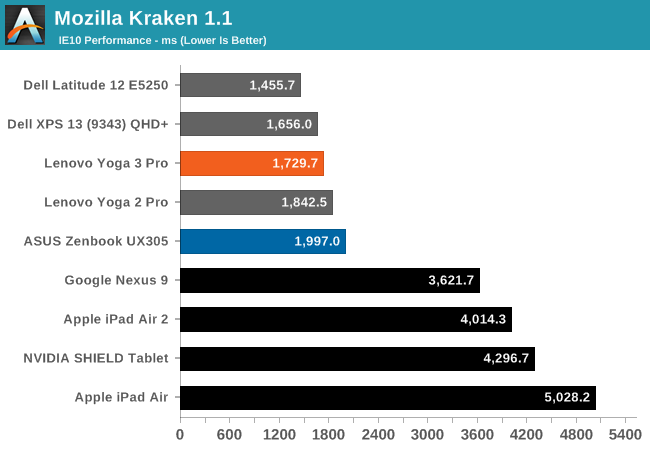

Running Javascript based browser benchmarks, the UX305 with Core M 5Y10 once again falls to the bottom of the chart. With just a 2 GHz boost clock, the 5Y10 struggles to compete against the likes of other laptops with faster Core M or U series processors. The ASUS UX305 cannot be converted into a tablet, but I have included some tablet benchmarks here just to show how Core M-5Y10 compares against the best performing tablets. With around the same power envelope, even the slowest Core M is still significantly faster than any tablet in CPU performance.
Explaining Core M Performance
On system performance, we have seen some fairly wild swings when comparing the UX305 with the slowest Core M processor available to other devices, especially the Yoga 3 Pro which has the fastest Core M released so far with the 5Y71. The Yoga 3 Pro even includes a fan, whereas the UX305 is passively cooled. On quick, burst benchmarks such as TouchXPRT, and on single-threaded benchmarks such as Cinebench, and even on the web tests the Yoga 3 Pro with 5Y71 offers a lot more performance. However on the longer benchmarks the UX305 pulls ahead despite the lower base and boost clock speeds.
Traditionally, it was just a given that higher numbered processors of the same processor family would give you better performance, but with the kind of devices Core M is being integrated into, that is not the case at all. There are a lot more factors at play when you look at Core M as a whole in order to understand where the performance level is going to be. For example, ASUS has opted to allow the processor to get much hotter, which then translates to higher surface temperatures on the device, especially since it is passively cooled. But this lets Core M keep its clock speeds higher when performing extended workloads. Lenovo on the other hand, even with a fan, has opted to keep the CPU temperature much lower, but that forces the CPU to throttle down under extended workloads. On a long test, the ASUS CPU hit as high as 80°C, but the Lenovo kept the CPU to around 60°C, and due to the fan, the surface temps of the laptop did not get warm very much at all.
The performance of Core M is much more akin to how a smartphone or tablet is limited in performance, where the manufacturer has to look at overall device temperatures and decide where they want to limit performance. ASUS has chosen a much more aggressive temperature, and it does not affect the device use very much because it is a laptop, and therefore can be used on a desk. You do not have to hold the device, so even though it can get to over 47°C (117°F) between the display and the top of the keyboard, the palm rests and keyboard never get warm at all. The aluminum chassis comes into play and can act as a large heat sink. Lenovo has chosen a much lower device temperature, but the Yoga 3 Pro is a convertible and can be used as a tablet, so having such a high surface temperature would be a big issue. Of course, if you are using the UX305 in your lap, it would be very uncomfortable as well, so watch out for that. For general tasks, the device does not get warm, but if you are doing extended heavy workloads, it can be an issue.
One such task which causes heavy use for extended times is gaming, so next up is GPU performance.










164 Comments
View All Comments
metayoshi - Wednesday, March 25, 2015 - link
I may be in the niche group right now, but I am pretty excited at what these 5W chips bring to the table. These chips are really where Windows on a tablet will stand out in my opinion. With much better performance than you get with the crappy Atom line of CPUs and with way better performance than anything ARM will provide, and then add in the millions of legacy programs that you can use on a full x86 Windows platform, and in my opinion, it's a winning combination. With products like Dell's Venue 11 Pro already upgraded to Core M, and with the upcoming Asus Transformer Book T300 Chi also coming in with Core M, and all for around $800, I find it worth the extra $300 to get better performance and get full blown Windows instead of being stuck in the limited Chromebook world. At this point, I'm waiting on reviews, and both of Anandtech's Core M reviews so far show me what I expected.Of course, I agree that this platform is not for everybody. A gamer should build their own gaming desktop, or invest in something like the Razer Blade if they want mobility, and a content consumer should just go Android Tablet, iPad, or Chromebook. But personally, I already have a gaming desktop at home that is overpowered for the task in my mind and would benefit from being mobile, but the task is incompatible with anything but Windows, so my smartphone or non-Windows tablet can't even run to program, and Atom is far too weak, so something with Core M is ideal.
In other words, if you don't want it, don't buy it. But to answer your top question, who asked for a 5 W notebook chip? I did.
eanazag - Monday, March 30, 2015 - link
I'm excited about these chips too because of battery life. For personal use I'd rather have some more gaming chops.I use a Surface Pro 1 for work and am happy with it except for battery life. The battery life isn't bad; I just know there is better out there and in consideration to my iPad I can't ditch the iPad.
r00fus - Wednesday, March 25, 2015 - link
Hyperbolic post is hyperbolic.Let us know how all your existing software runs on an ARM chip.
Go buy yourself a monster laptop if you want. I like having an option of a slim, sleek fanless form factor, even if the performance isn't top notch.
wetwareinterface - Wednesday, March 25, 2015 - link
because the MAINSTREAM of the notebook market won't even use the paltry power this offers. the MAINSTREAM user needs a web browser, a picture viewer, video playback software and at rare intervals the ability to run office. 8GB of ram means they won't need an upgrade for a long time.V900 - Thursday, March 26, 2015 - link
But after a couple of weeks the MAINSTREAM will start to get annoyed with the slowdowns, the heat and the fact that you can't have more than a few programs running at once, whitout the laptop throttling down constantly. MAINSTREAM is especially annoyed how everything comes to a crawl when they're doing the virus scans. Because 8GB RAM doesn't change the fact that the puny 5 watt ceiling means that it spends half the time below 1 GHZ and with one core turned off.MAINSTREAM quickly realizes that much of the time, their iPad does a quicker and better job at looking something up online, or replying to an email.
V900 - Thursday, March 26, 2015 - link
Hey now! Apple certainly didn't put this halfassed, asthmatic excuse of a CPU in the MacBook Air.It's the craptastic 12 inch MacBook that has to suffer the indignity of being powered by a CoreM.
(And while I love Apple products and got an i-everything myself, both Apple and Apple fanboys have finally jumped the shark with the 12 inch MacBook. And the Koolaid-swillers can't believe how innovative it is: "It only has ONE port! So brave and futuristic!"
akdj - Saturday, March 28, 2015 - link
It's also fabless, with PCIe storage that flat FLIES, an excellent iGPU that'll help that meager Core m processor that is essentially as fast as the quickest core2duos (mobile)! As well, an operating system that scales your UI properly and sure, a single port. It's 'portable'. Not meant to be connected.You can certianly (& already) buy the proper docks and/or adaptors necessary to utilize USB 3, HDMI or VGA, & power it simultaneously. The traditional bottleneck for the 'mainstream' has NEVER been the CPU. Rather it's memory, storage sub system, OS or a combination of all at the above...including GPU. While you're an Apple fan, you should know just how great these displays and their HiDPI scaling through OS X (& iOS) has gotten since the release of the 2012 models and 'new' iPad (3).
This IS the computer for the 'Apple fanboy Kool-Aid swillers' unlike you and I that obviously need a bit more horsepower, I/O or 'strength' from our laptops. Most, don't. They're doing the 'lifting' at work on a supplied work station. They're using their MacBook to edit family photos, videos, neither using Premier, AE, Smoke or even FCPx ...nor photoshop. They're using iPhoto and iMovie, NEITHER of which will be slowed down to the point of frustration as they're doing what they NEED it to. Surf the web, check email, Facebook and Twitter, watch a flick or listen to music, even ALL those processes, simultaneously running won't create any 'perceived slow down' by the end user of they're not in need of the processing power and amount of ports you somehow believe we all need.
I get it. And own a pair of 15" rMBPs and they're the best computers I've ever owned, and to think it started on a IIe and monochrome display! That said, we get it, you're disgusted but guess what? ASUS literally JUST released the same 'halfassed, asthmatic of an excuse of a CPU' in their latest Ultralight line. Bit less money, but lesser IGPU, lesser storage speeds, and severely lacking display OOB without calibration. It's got your ports, but again I ask, Why?
Why the ports? Why a quad core i7 Xeon with GPUs in SLI? When no one wants anything p,urged in to their laptop on the train, on the plane or on the go? No need to charge, it lasts ten hours --- but if u need it, buy the 13" rMBP. Same tech, all the IO you seem to need and not so anemic a CPU
As an Apple fan myself, it's sad to see another 'fan' so clueless and ignorant to what a portable, laptop design should and shouldnt be (like the crappy hinge on the ASUS)
And you get OS X, an operating system built and 'intended' for maximum end user enjoyment and Performance --- 'real or perceived', it's irrelevant.
It's always nice to leave work at home
Haravikk - Thursday, March 26, 2015 - link
Who asked for a 5W notebook chip? To me the answer is anyone concerned about battery life and/or size; having to put a fan in a notebook adds to its bulk, not to mention making noise, reducing room for batteries and, if the processor needs a fan, reducing that battery life even further.Granted the screens are really the most demanding component these days, especially high-densisty screens requiring stronger backlights, but hopefully this will go down too (and you can run at reduced brightness to get some extra time out of the battery). But yeah; battery life improvements require everything to get more efficient, and that includes the processor. It might not be a massive leap in performance (or an improvement at all, depending upon what you're doing with it), but the efficiency improvements are enormous.
ragenalien - Thursday, March 26, 2015 - link
Because it's easier for intel to improve the power to performance ratio than merely making the chips faster with the same power. They've been doing this since sandy-bridge and it doesn't seem like they'll change that any time soon.frodbonzi - Thursday, March 26, 2015 - link
Except this laptop is $699.... not $1300...And for that "extra" $200, you get a thin, shiny laptop capable of doing 99% of what the "normal" user will want...You want to play uber games... buy an Alienware 18!